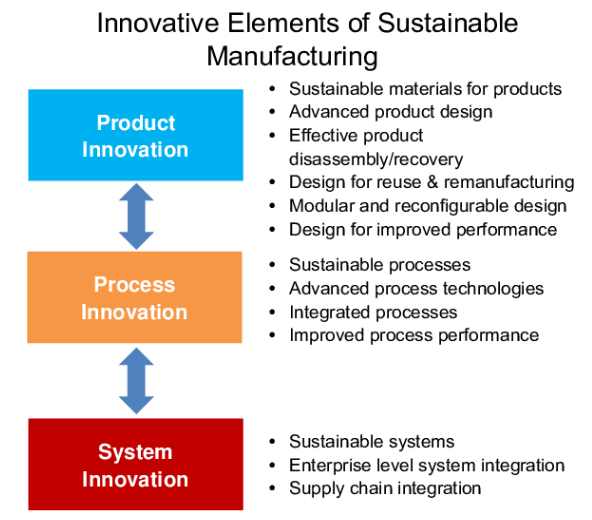Lesson 7 – ECO innovation
Eco-innovation plays a crucial role in addressing environmental challenges and achieving sustainable development goals. By fostering creativity and the adoption of more sustainable practices, eco-innovation contributes to the transition towards a greener economy and a more resilient and environmentally conscious society. Governments, businesses, and individuals all play essential roles in driving eco-innovation and creating a positive impact on the planet.
Eco-innovation focuses on developing and implementing new technologies, methods, and practices that contribute to sustainability, resource efficiency, and environmental protection. Here’s an overview of the aspects of eco-innovation: The different types of eco-innovations can generally be grouped into three main categories; process, product and system innovations.
- Innovative Products: This aspect of eco-innovation involves creating new or improved products that are environmentally friendly. These products are designed to have a reduced carbon footprint, consume fewer resources, or be made from recycled or biodegradable materials. Examples include electric vehicles, energy-efficient appliances, and sustainable packaging materials.
- Processes: Eco-innovation in processes relates to finding new and more sustainable ways to carry out various industrial or business activities. It often involves optimizing resource use, minimizing waste generation, and reducing harmful emissions during manufacturing or production processes. Implementing renewable energy sources, adopting closed-loop production systems, and using water-saving techniques are all examples of eco-innovation in processes.
- Organizational Innovations: This aspect of eco-innovation refers to changes in the management or operational structure of a company or organization to promote sustainable practices. It can include adopting environmentally responsible policies, setting up green supply chains, encouraging employee engagement in eco-friendly initiatives, and integrating sustainability into the core values of the organization.
Eco-Innovations involve the development and implementation of new technologies, processes, products, or services that have a positive impact on the environment. These innovations aim to address environmental challenges while also providing economic and social benefits. Eco-innovations can span various industries, including energy, transportation, agriculture, and manufacturing.

Fig 8 Examples of innovative aspects in sustainable manufacturing at product, process and system levels. Available at: https://www.collidu.com/presentation-green-public-procurement
Key aspects of Eco-Innovations include:
Sustainable Design: Creating products or services with reduced environmental impact in terms of energy consumption, emissions, and resource use.
Circular Economy: Designing products and systems that promote recycling, reusing, and minimizing waste to create a closed-loop system.
Renewable Energy: Developing and implementing technologies that harness renewable energy sources like solar, wind, and hydro power.
Green Technologies: Utilizing innovative technologies to address environmental challenges, such as pollution control, water conservation, and waste management.
Relationship between GPM and Eco-Innovations:
Green Project Management (GPM) and Eco-Innovations are two concepts that are closely related and often go hand in hand in the context of sustainable development and environmental management.
The relationship between Green Project Management and Eco-Innovations is symbiotic. GPM provides the framework and guidelines for incorporating sustainable practices into project management processes. Eco-Innovations contribute to the realization of these sustainable practices by offering new solutions, technologies, and approaches that align with GPM principles.
In practical terms, GPM may involve the integration of eco-innovations into project designs. For instance, a construction project following GPM principles might incorporate eco-innovations like green building materials, energy-efficient technologies, and waste reduction strategies. Conversely, eco-innovations can arise as a result of the research and development efforts undertaken during GPM implementation. Project teams, while striving to meet sustainability goals, may discover or create innovative solutions that have broader environmental applications.
In summary, Green Project Management and Eco-Innovations are intertwined concepts that together contribute to sustainable development by fostering environmentally responsible project management and the development of eco-friendly solutions.
Lesson 7, Inspired by: https://www.unep.org/eco-innovation